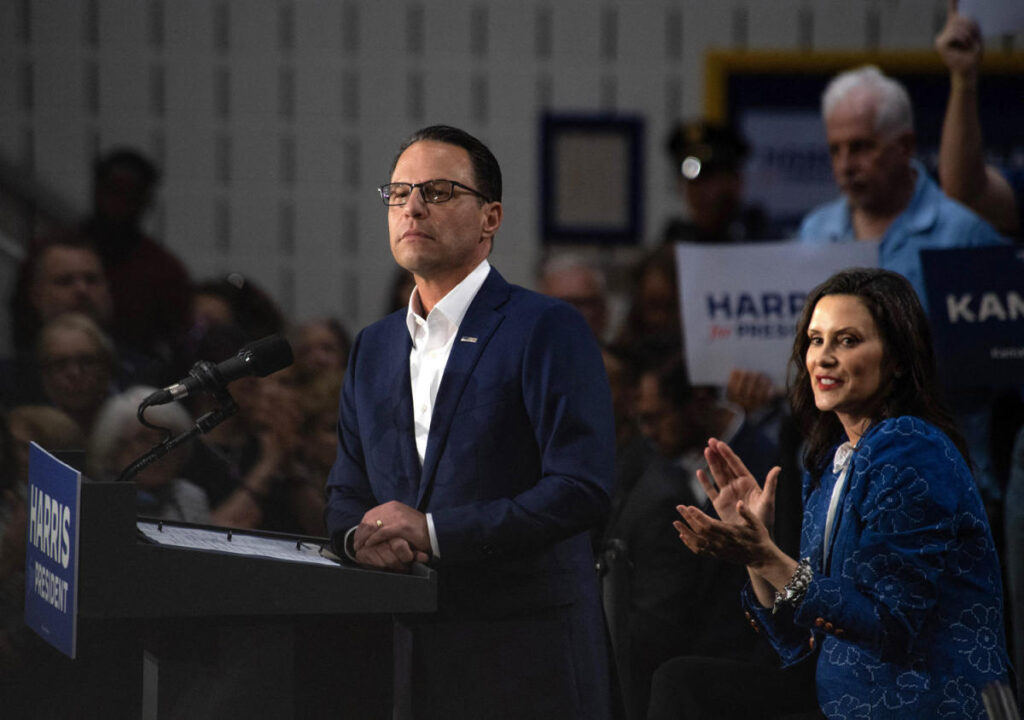In the wake of Vice President Kamala Harris’ unexpected defeat to President-elect Donald Trump, the Democratic Party faces the daunting task of regrouping and strategizing for the future. As the party navigates through a turbulent landscape, various potential leaders are emerging, each vying to shape the party’s opposition to Trump’s anticipated second term. With the 2028 presidential primary on the horizon, attention is particularly focused on a cadre of prominent governors and legislators who have succeeded in crafting their own identities and garnering national support. Key figures include Michigan’s Gretchen Whitmer, Pennsylvania’s Josh Shapiro, California’s Gavin Newsom, and Illinois’ JB Pritzker—individuals who stand apart from President Biden’s administration and are poised to mobilize state executive power against federal policies propelled by Trump.
Strategists within the Democratic Party are contemplating how the landscape will evolve over the next few years, particularly regarding the interplay between state-level governance and national resistance to Trumpism. Jared Leopold, a former official at the Democratic Governors Association, illustrated that the current crop of Democratic governors, unlike their less-known predecessors in the 2020 presidential race, have emerged as familiar names and influential actors within the party. Their prominence is expected to enable them to lead the Democrats effectively through this challenging phase. The dynamics of the Senate, particularly as it transforms into a more robust minority, could complicate efforts for backbench senators to gain national attention, underscoring a potential shift in leadership strategy within the party.
With the departure of Biden’s administration, the Democratic response to Trump is anticipated to be decidedly more proactive. Strategists like Caitlin Legacki emphasize the need for creativity in advocacy as the party contends with fatigue among constituents, financial restraints, and an overall grim attitude towards governance. The call for innovative, forward-thinking approaches to engage voters highlights that merely opposing Trump may not be sufficient; Democrats will have to offer substantial policy advancements and articulate a compelling vision for the future to rekindle enthusiasm among their base.
Potential presidential hopefuls like Newsom and Pritzker have already begun strategizing, using Trump as a foil to ignite support for their respective agendas. Newsom’s plans to convene a special session in California to defend “California values” from Trump’s impending administration exemplifies this tactic of positioning state governance as a bulwark against federal threats. Similarly, Pritzker’s commitment to safeguarding democracy through collaborative initiatives with other governors showcases the proactive stance being adopted by these leaders. The motivations of key figures—whether they lean towards resistance against Trump’s policies or choose a more conciliatory stance—will play a pivotal role in determining the Democratic Party’s direction and appeal heading into the next election cycle.
Prominent figures like Whitmer and Shapiro are also stirring conversation regarding their future ambitions, particularly as they both achieved significant victories in the 2022 elections. Their positions, coupled with their political legacies, have placed them prominently in discussions about 2028 candidacies. Despite the lingering consequences of Harris’ loss, which overshadowed the electoral successes of these governors in their own states, both are seen as capable leaders with considerable grassroots support. Insights from fellow Democrats suggest Shapiro, in particular, is almost certain to explore a presidential run, given his strong appeal in Pennsylvania—a critical battleground state—and valuable connections among potential supporters.
Beyond governors, a diverse range of Democratic figures is charting potential pathways to influence party dynamics, including senators such as John Ossoff, Raphael Warnock, and Mark Kelly. Gallego’s recent victory signals a possible shift in the party’s alignment with core Latino voters, while other senators and governors are considering innovative approaches to engage constituents disillusioned with traditional politics. Figures who previously ran in 2020, such as Cory Booker, Amy Klobuchar, and Pete Buttigieg, could also seek to reposition themselves for future campaigns, as the overall landscape allows for outsider candidates to emerge. In light of the electorate’s mood and growing expectations for authenticity, the Democratic primary is likely to shift towards candidates capable of presenting innovative ideas rather than merely adhering to established party lines.
As the Democratic Party navigates the complexities of this new political climate, key leaders are cognizant of the urgent need for agility and a clear articulation of values to appeal to voters. With ample talent emerging from both established and progressive factions within the party, the groundwork for the 2028 primary is being laid. Ultimately, the success of Democratic candidates will hinge not only on their response to Trump’s policies but also on their overall charisma, approachability, and ability to forge genuine connections with voters disillusioned by the current political landscape. With various contenders likely to emerge, the Democratic primary process is poised to witness a blend of traditional strategies and innovative campaigns that resonate with a broadly diverse electorate.

